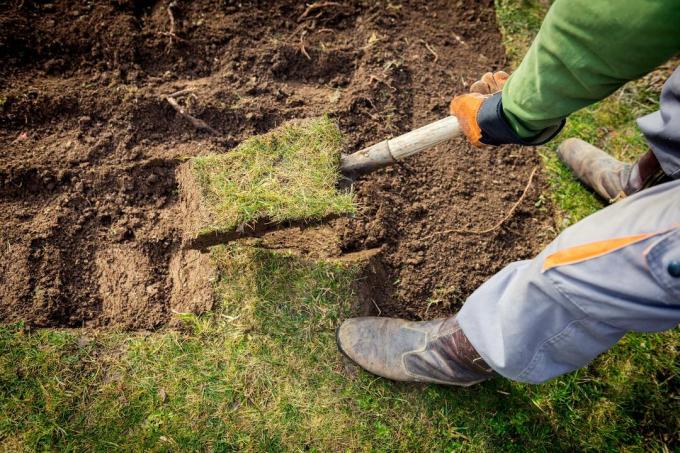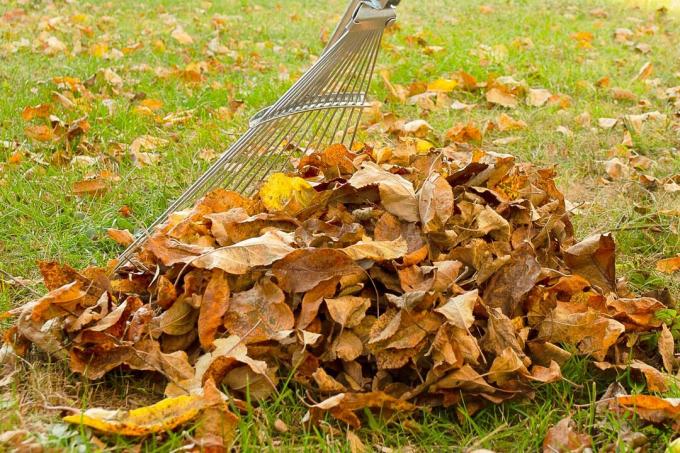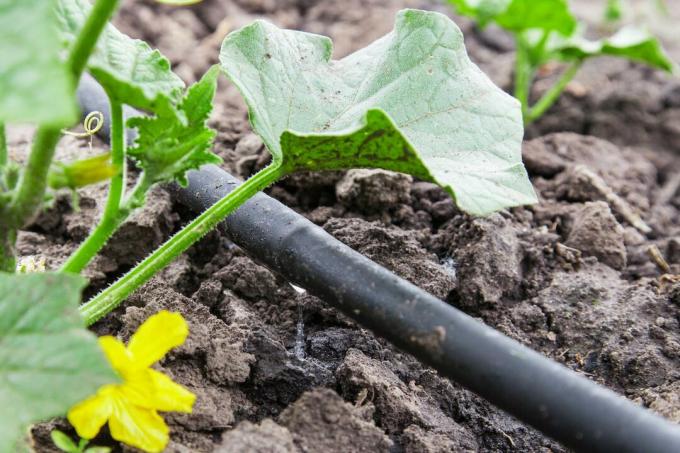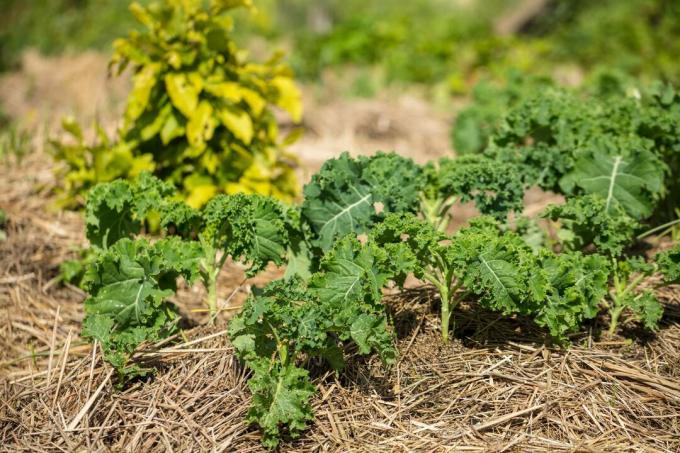Many gardeners swear by hill beds. We reveal the advantages and disadvantages of this and show you how to properly create and plant your own hill bed.

contents
- What is a hillbed?
-
Create a hillbed: that's how it works
- List of layers of a hill bed
- Proper irrigation for the hillbed
- Plant hillbed
- Which vegetables are suitable for the hillbed?
- Permaculture in the hillbed
- Advantages & disadvantages of a hill bed
What is a hillbed?
A hill bed is a bed in the garden that is raised towards the middle and creates a favorable climate for growth through the layering of various organic materials. A raised bed has the same advantages as a raised bed, for example higher yields without additional fertilization. However, hill beds are easier to build than raised beds, as they do not have a border, for example made of wood.
Create a hillbed: that's how it works
The best time to create a hillbed is in autumn. Then there is plenty of filling material such as leaves for the bed and the stacked layers can settle well until next spring. Any place that is not completely in the shade is suitable as a location in the garden. The following dimensions should be observed when creating:
- Height: max. 1 meter
- Width: max. 1.5 meters
- Length: max. 4 meters
A north-south orientation of the bed is recommended when laying it out, as this way the entire area of the bed receives enough light. In preparation, mark out the area you want your bed to have. The maximum width of 1.5 meters has been chosen so that the middle of the bed can still be easily reached in order to carry out planting and maintenance measures. The bed should also not be too narrow or too high, otherwise the soil will slide off the sides. The staked area is then excavated about 25 centimeters deep. You can put the cut turf to one side, it will be used later. As the last step of the preparations, a wire mesh is placed in the dug pit to protect against voles. Layering can now begin.

Instructions for building hill beds in a nutshell:
- Stake out the desired area
- Dig a hole approx. 25 cm deep
- Lay out chicken wire for protection
- Layer different materials
- Always knock on all layers well
There are no limits to your imagination when designing your hill bed. You can leave the bed unpaved, but the hill bed can also be attached to the sides with stones or wood.
List of layers of a hill bed
The secret of the many advantages of a hill bed lies in the five different layers. The bottom layer is cut up 40 centimeters high and chopped up clippings, i.e. branches and twigs. The next layer is formed by the turf that was created when the pit was excavated. These are piled up with the grass side down. Next is a 20 centimeter high layer of damp leaves or straw. But garden waste can also be used - just take what is there. The next layer consists of manure or young, little rotted compost. It is piled up about 15 centimeters high. The topmost 20 centimeter high layer of the hill bed consists of garden soil mixed with ripe compost.

The five layers of the hill bed at a glance:
- 40 cm of chopped branches and twigs
- 15 cm turf sod
- 20 cm of damp leaves or straw
- 15 cm of manure or young compost
- 20 cm of garden soil and ripe compost
Proper irrigation for the hillbed
Watering hill beds properly is not an easy task. There are two reasons for this: the water flows off quickly over the sides and the top layer dries out quickly due to its loose structure. A good way of ensuring the bed's water supply is to have a rain and watering trough on the apex of the bed. In addition, smaller hollows for water storage can be created around the bed. Professionals water their hillbed with hoses between the vegetables. A mulch layer made of leaves or grass clippings can also secure the water supply, which protects against drying out.

Properly watering hill beds at a glance:
- Create hollows and gutters to store water
- Irrigation with hoses
- Mulch layer protects against drying out
Plant hillbed
In principle, you can plant anything you like on your hill bed. You just have to make sure that the bed is not illuminated by the sun to the same degree in all places and that in the first year most of the nutrients are in the bed, which slowly increases over the years use up. The rule of thumb is therefore to consider the sun's rays and the different nutrient requirements of the individual vegetables when creating a planting plan. In general, pre-grown plants are suitable for the hill bed, as seeds are easily washed away on the still loose soil and the sloping sides of the bed.
What should you watch out for when planting a hillbed?
- Exposure to sunlight
- Nutritional requirements of plants
- Number of years of use
- Better grown plants than seeds

You can get more tips on planting hill beds from our Planting plan for raised beds copy. After all, the same conditions prevail on the hill bed as on the raised bed, which is why the same can be cultivated.
Which vegetables are suitable for the hillbed?
Which vegetables are grown after the creation of the hillbed depends on the nutritional requirements of the vegetables. Most of the nutrients are still available in the first year; therefore the bed is planted with so-called heavy eaters. For example tomatoes (Solanum lycopersicum), Cucumber (Cucumis sativus), Pumpkins (Cucurbita), zucchini (Cucurbita pepo subsp. pepo convar. giromontiina) as well as various types of cabbage such as cabbage (Brassica oleracea var. capitata), broccoli (Brassica oleracea var. italica) or cauliflower (Brassica oleracea var. botrytis). In the further year, the middle eaters, i.e. vegetables with medium nutrient requirements, follow. The skill Strawberries (Fragaria), Beetroot (Beta vulgaris subsp. vulgaris var. conditiva), Carrots (Daucus carota subsp. sativus), Onions (Allium cepa), garlic (Allium sativum) or Kohlrabi (Brassica oleracea var. gongylodes L.) be.
In the first two years neither should be on the hill bed spinach (Spinacia oleracea) still salad (Lactuca) because these plants would absorb too much nitrate. From the third year onwards, weak eaters are cultivated on the hill bed. These include, for example, lettuce and spinach, radish (Raphanus sativus var. sativus), various legumes such as peas (Pisum sativum) or Beans (Phaseolus vulgaris) and various herbs such as dill (Anethum graveolens), Borage (Borago officinalis) or parsley (Petroselinum crispum ssp. crispum). After six years most of the nutrients in the bed have been used up and it is time to start a new one.

Tip:potatoes (Solanum tuberosum) should never be planted on a hill bed. Unfortunately, the plants destroy the layers of the bed.
Planting plan for the hill bed at a glance:
- 1. Year: Heavy eaters such as tomatoes, zucchini, pumpkin, various types of cabbage
- 2. Year: Medium eaters such as carrots, strawberries, kohlrabi, onions, beetroot
- From the 3rd Year: low consumers such as lettuce, beans, peas, radishes, spinach, herbs
- The hill bed should be renewed after 6 years
The hill bed can of course not only be filled with vegetables, but also with flowers or both Mixed culture be planted.
Permaculture in the hillbed
Hill beds are often used in permaculture gardens because they combine many principles of Permaculture in itself: garden waste can be used and recycled and vegetables can be grown for many years without additional fertilizers. Additional tillage is not necessary. This is also an important element when creating a hillbed according to the principles of permaculture Mulching, which protects the bed from drying out and weeds.

Advantages & disadvantages of a hill bed
Hill beds have many advantages: The hill increases the area under cultivation and there is more solar radiation. In addition, garden waste can be recycled and plants are naturally supplied with nutrients. Another advantage is that the construction is simple and no additional building material is required (other than wire mesh). The rotting process inside warms up the bed and thus offers better growth conditions for plants. It also extends the cultivation phase. Added to this are the nutrients released by the rotting for the plants. All of this ultimately leads to higher yields. It should also be mentioned that the increase makes it easier to work on the bed and that you do not have to bend down so much. The disadvantages of hill beds should not be concealed either. Unfortunately, voles find ideal homes in hill beds and disrupt the cultivation of vegetables. The supply of water is also not easy with a hill bed. In addition, the soil on the sides of the bed needs to be regularly repacked as the sides tend to slide off.
The advantages and disadvantages of hill beds at a glance:
The following table shows the advantages and disadvantages of hill beds.
| advantages | disadvantage |
|---|---|
| Recycling of leftovers | Voles |
| Easy to build | Water supply |
| Enlarged cultivation area | Should be piled up regularly |
| Higher exposure to sunlight | |
| Warming from within | |
| No fertilization necessary | |
| Higher yields through extended cultivation phase | |
| Better working height |
Another possibility, similar to the hill bed, to create a bed is a No-dig beet. No digging is necessary. We'll explain what it's all about and how to go about it.



